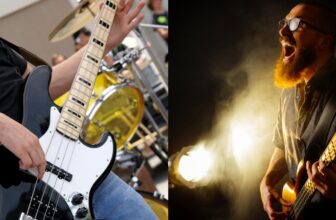The 15 Most Important Marching Band Instruments
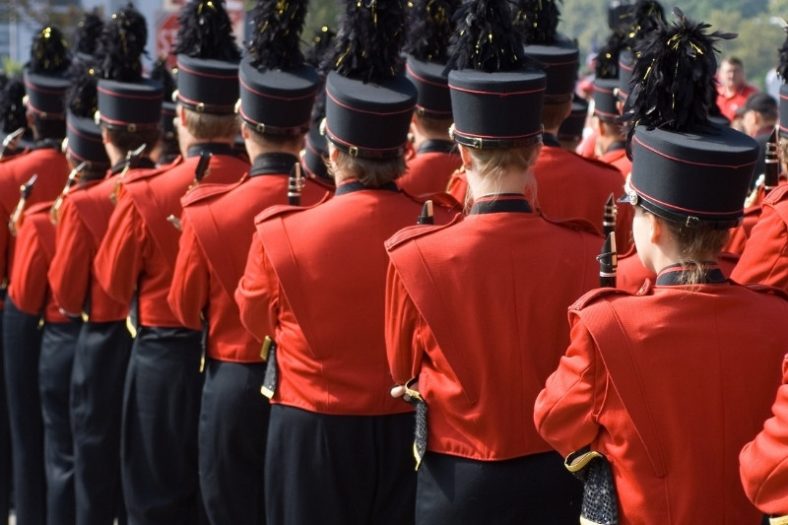
Marching bands are a unique source of entertainment. They are made up of several different instruments that when synchronized together, give a beautiful sound to the audience.
If you’ve ever been to a parade or a sporting event of any kind, you probably remember seeing a marching band and experiencing it firsthand. The beauty in this form of art is bringing together a variety of different instruments that form an in-sync musical performance that will impress many.
Marching Bands can often consist of around 30 musicians, but they can go as high as over 300 musicians at the same time. So imagine hearing this live, it will without a doubt be memorable for anyone.
Contents
Percussion Instruments
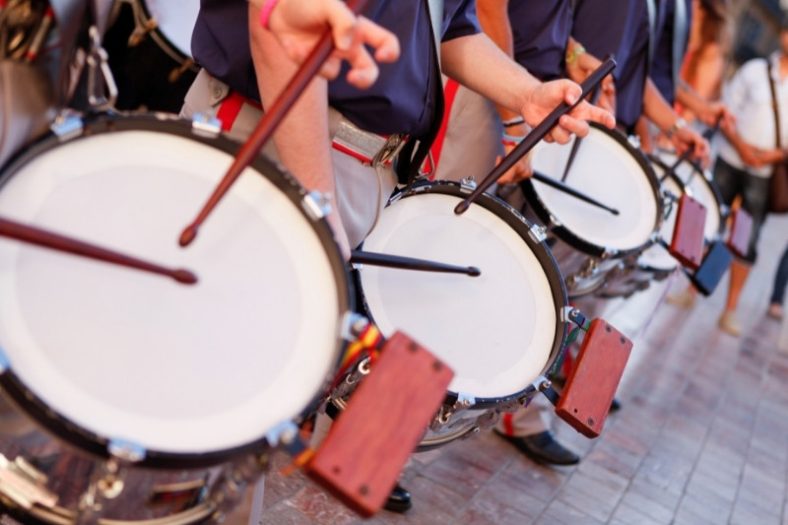
Starting off with percussion instruments. They play a key part in any marching band because they are in charge of keeping the tempo for the entire band. Percussion instruments in a marching band include snare, tenor, and bass drums as well as cymbals, woodblocks, and glockenspiel.
Snare Drum
The snare drum is a commonly known instrument in any marching band. It provides a strong, decisive beat. You might have noticed various solos and drum rolls being performed on a snare drum, which is why it’s an essential part of percussion instruments in any marching band.
Tenor Drum
Tenor drums are an accompanying element to the snare drums. They are a set of drums, composed of four to six drums that are mounted together making them easier to carry and easier to play. The most common composition of tenor drums is four main drums and two accent drums, together forming a complete set that is carried using straps, applied to the musician.
Bass Drum
The bass drum is quite larger than all the other drums. It produces a very powerful, deep bass sound. Its main purpose is to add depth to the entire composition. Although it doesn’t require a lot of playing dynamics, it’s a crucial part of a good marching band.
Cymbals
While mentioning cymbals, people would often think of cymbals that are mounted to a drum setup, this is not the case in a marching band. Cymbals are often a pair of two, held by the hands of the musician and played by striking them together. This differs from a regular drum setup, as it requires a single cymbal being mounted and struck. They are round-shaped, metallic plates that are held by their center and produce a high-pitched sound.
Wood Blocks
Wood Blocks are pretty simple creatures. They can add an exciting element to the composition and provide a bright sound that is commonly used in marching bands today. They are made of wood and are bar-shaped.
Glockenspiel
The glockenspiel pretty much resembles the wood blocks, but it’s made of metal bars that produce higher tones. This instrument is strapped on the shoulders of the musician because it’s a considerably large instrument. It has really fun aesthetics, as it’s arranged in a pair of sections, each providing a different tone when struck.
Brass Instruments
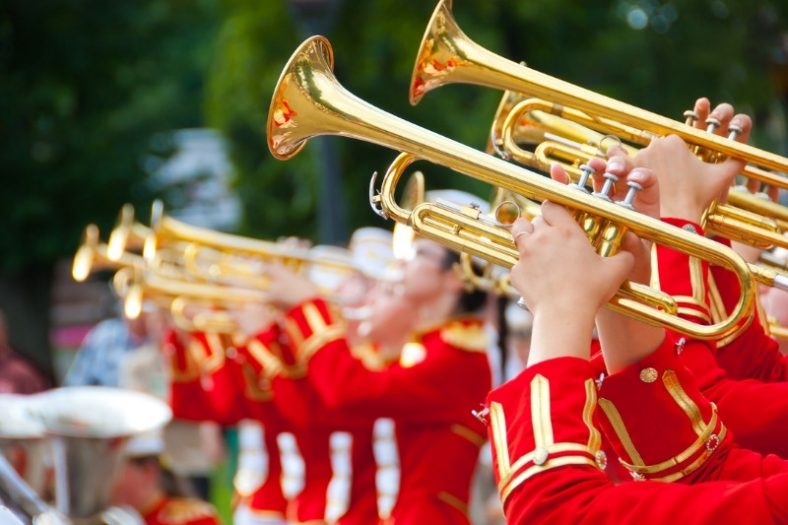
The marching band’s brass section consists of a variety of instruments that provide vibrating and rich tones to the music. With their shiny look and distinct shape, they’re by far the most attractive piece in any marching band.
Trombone
The trombone is a very unique instrument. It’s used in many styles of music as well as in marching bands. It uses a sliding system, consisting of a sliding pipe that when adjusted, plays a variety of different notes and is most commonly used for melody or harmony in the marching band.
Trumpet
The trumpet highlights the brass section in many ways. It is perhaps the key element within this section that’s played by blowing through a blowhole with closed lips, which produces very beautiful musical tones. They often play the main melody but are also known to play harmony as well.
Cornet
The cornets are much smaller than the trumpets. It does, however, share a similar shape, as it also has a similar style for playing by using closed lips and blowing through the blowhole. The musician manipulates the valves on the cornet, to produce a variety of different tones. It is also a very common instrument in any marching band.
French Horn
Another important part of the brass section is the French form. It produces a deeper sound which adds to the depth of the music as well as provides a good foundation. Because of its shape, it’s commonly used to provide a more intense sound because, unlike its counterparts, its bell faces forward instead of backward or sideways.
Sousaphone Tuba
An extremely important but accompanying instrument is the tuba. It provides the lowest sound in the marching band, with bass tones that add rhythm as well as harmony to the music. It’s extremely large but it plays a crucial role in a marching band nevertheless.
Woodwind Instruments
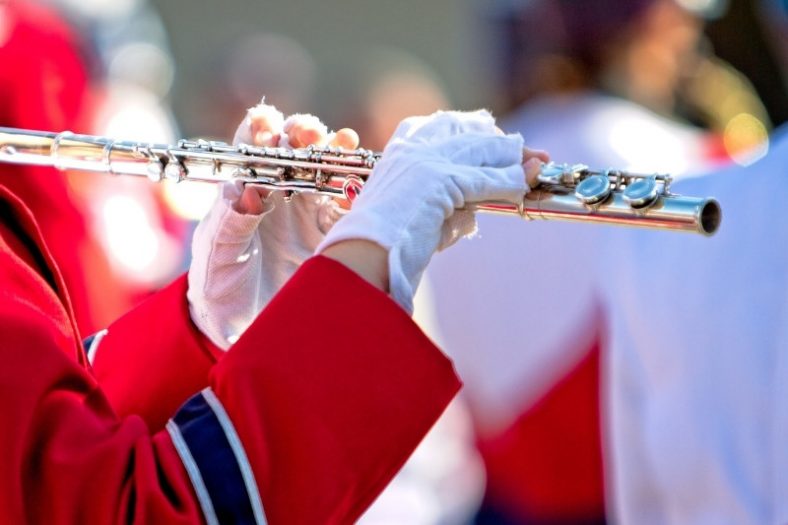
The woodwind instruments add a lot of variety to the composition of a marching band. Its interesting jazzy melodies greatly influence the whole composition. They are considered the voice of the marching band because they are easily distinguished from all the other instruments.
Flute
The first one on the list is the flute. It provides a very beautiful, high-pitched sound that often carries the melody of the composition. The flute is used for solo performances that play an important part in any marching band because it highlights certain parts that are memorable for any audience member.
Piccolo
The piccolo is very similar to the flute, with the only difference being that it is way smaller in size. Being smaller results in playing the highest-pitched tones in the marching band that also adds certain vibrations and is used for solos too.
Clarinet
With its cylindrical shape, the clarinet produces both high and low sounds. It’s a reed instrument that is straight on one end and ends with a bell on the end. It’s more commonly known for its wide range of sounds that play an important part in any marching band. It also shares similarities to the flute except for the fact that it produces low tones.
Saxophone
While more commonly known for its use in jazz music, the saxophone is also a key component in any marching band. This instrument comes in many different forms, as there are different types of saxophones including the tenor saxophone, the alto saxophone, and the baritone saxophone, and many others. All have been known to be used in marching bands. While some play really deep, bass sounds, others provide more high-pitched tones.
The Purpose of Marching Bands
Marching bands have a huge historical significance. They were often used on the battlefield decades ago and we’re often formed of military people. Historical facts prove that since the 11th century, a tradition was formed that included a marching band in each army.
Much like today, they had the purpose of raising morale as well as providing entertainment. This can also be said about today’s marching bands, which are often used for entertainment or even competitions.
Marching bands are commonly known to wear uniforms that are oftentimes military, with some kind of symbol or name, as well as the colors of a certain organization. For example, high school and college marching bands often include a color guard that is represented with flags and various musical props.
Summary
Marching bands are a very common form of entertainment during any sporting event or parade, with a really interesting background of historical significance. Despite being used for centuries, it is still used today. Many people consider the full performance of a marching band as a really incredible experience. They include lots of different instruments coming together to provide an in-sync musical performance that just leaves you in awe. It’s an important form of entertainment that is unlikely to die out as time goes on.


